
In the latest of their ‘new generation system cameras’, the compact PEN E-PL1, Olympus is aiming for ease of use and portability while offering good image quality of a large image sensor. The Olympus E-PL1 was announced internationally last Wednesday and we have a preview of this latest camera which joins in the growing array of Micro Four Thirds cameras. Hit the link for all the juicy details about the camera.
*Note from Brad: A big thank you to the folks at Olympus who made previewing of the PEN E-PL1 on DPInterface possible.
DPInterface Olympus PEN E-PL1 Preview
Brad Soo – February 8th, 2010
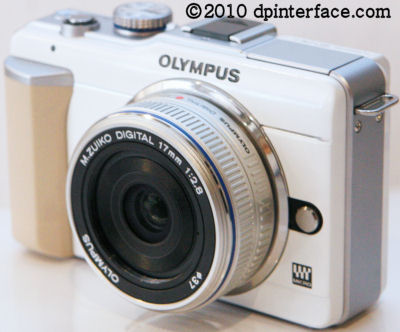
The Olympus PEN E-PL1 is Olympus’ third Micro Four Thirds/PEN camera. This time they’re catering to the masses; compact camera users and beginners, with the new E-PL1. The Olympus PEN E-PL1 isn’t just a E-P2 with a new skin and lower price tag, it sports several new features, some of which are specifically tailored for beginners.
Before we move on, here’s what the Olympus E-PL1 has in store for you:
- 12 effective megapixels
- Micro Four Thirds lens mount (Also takes full-size Four Thirds and some Leica lenses via their respective adapters)
- 2.7 inch LCD (230,000 pixels) with live view
- 3 frames per second burst mode
- ISO range of 100 - 3200
- Point-and-shoot functions and Art Filters
- Full manual controls
- New Live Guide feature for easy adjustment of various camera settings
- Accessory port for external EVF and dedicated stereo microphone
- 720p HD movie mode, records at 30 FPS with sound
- New built-in flash and improved ergonomics
- HDMI output port
And here’s my usual disclaimer for camera previews: the Olympus PEN E-PL1 unit previewed here is a pre-production model. That means things here are subject to change and you should NOT judge the Olympus PEN E-P2 until our final review comes out. All product shots will be retaken once I get my hands on a 100% finalized, retail version of the Olympus PEN E-PL1 in the future.
Now, let’s take a closer at the Olympus PEN E-PL1!
Size and Weight
(226.9) 120.6 x 69.9 x 36.4 mm (335 g) – Olympus E-P1
(226.9) 120.5 x 70.0 x 36.4 mm (335 g) – Olympus E-P2
(228.3) 114.6 x 72.2 x 41.5 mm (296 g) – Olympus E-PL1
(258.8) 124.0 x 89.6 x 45.2 mm (385 g) – Panasonic Lumix G1/GH1
(226.3) 119.0 x 71.0 x 36.3 mm (285 g) – Panasonic Lumix GF1
All the weight figures above show when the camera is empty without any lens, battery or memory card
The Olympus PEN E-PL1 is a small camera – closer in size to some ‘prosumer’ compact cameras rather than digital SLRs that it competes with. The PEN E-PL1 is slightly narrower but taller than its higher end PEN siblings; it also measures slightly thicker thanks to the more prominent right hand grip.

Here’s the Olympus PEN E-PL1 compared to the Panasonic Lumix GF1. The Olympus E-PL1 is a less boxy camera!
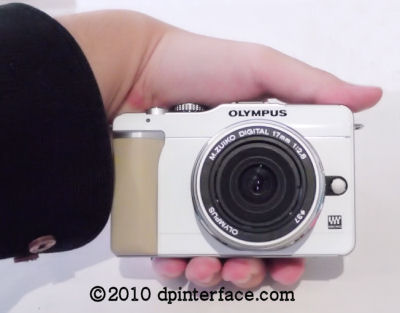
Not sure what happened to the color of my hand up there (my hand normally looks like this) when I took the picture using a compact camera I had with me… but anyway, as you can see, the Olympus PEN E-PL1 is a relatively compact little camera.
I have been using the similarly-sized Panasonic GF1 for quite a while and when I don’t want to bring a conspicuous looking camera bag with me, I can easily take it apart and stuff it in my pants pocket; body only in one pocket, kit lens in the other. I’m sure you can do the same with the PEN E-PL1, albeit with a slight bulge – a camera bag or carrying case is definitely recommended if you prefer comfort!
Box packaging
The Olympus E-P2 PEN will come with your standard interchangeable lens camera bundle along with Olympus’ newly launched iB (I’m guessing it stands for ‘image browser’?) photo organizing/processing software:
- Olympus PEN E-P2 camera body
- BLS-1 rechargeable lithium-ion battery
- Battery charger
- Neck strap
- USB and A/V cables
- Camera software CD (includes new iB photo organizing software)
- User’s manual
- Olympus Micro Zuiko 14 – 42 mm f3.5 - f5.6 kit lens
As of launch, the Olympus PEN E-PL1 is currently only available with one ‘kit’, and that’s the one with the 14-42 mm kit lens bundled with the camera. Olympus is targeting users stepping up from the compact camera market with the PEN E-PL1 so it’s great they will have just one kit as so not to confuse beginners with too many choices.
The Olympus PEN E-PL1 doesn’t include any internal memory or memory card, so you need to use your own. Like the other two existing Olympus PEN cameras, the PEN E-PL1 takes just SD/SDHC cards (no support for xD-Picture cards here!) and a 4 to 8 GB card will be good to start with. The PEN E-P2 is able to perform faster when using a high-speed memory card (90X to 150X speed will do) so consider picking up one with the camera.
500 shots – Canon Digital Rebel T1i aka 500D
190 shots – Canon Digital Rebel T1i aka 500D (LCD live view)
510 shots – Nikon D5000
210 shots – Nikon D5000 (LCD live view)*
500 shots – Olympus E620
200 shots – Olympus E620 (LCD live view)*
300 shots – Olympus PEN E-P1 (LCD live view)
300 shots – Olympus PEN E-P2 (LCD live view)
290 shots – Olympus PEN E-PL1 (LCD live view)
330 shots – Panasonic Lumix G1 (LCD live view)
300 shots – Panasonic Lumix GH1 (LCD live view)
380 shots – Panasonic Lumix GF1 (LCD live view)
640 shots – Pentax K-x
500 shots – Sony Alpha A380
230 shots – Sony Alpha A380 (LCD live view)
*In-house testing done by DPInterface. Our tests were conducted as close as possible to CIPA’s procedures
All the cameras above are rated with rechargeable batteries according to CIPA Standard; when using the viewfinder, unless noted otherwise
The Olympus PEN E-PL1 shares the same BLS-1 type rechargeable lithium-ion battery as its siblings. I find it puzzling how the camera managed to get a slightly lower battery life estimate (290 shots) than the other two PENs, seeing it’s a more basic model, and it uses a smaller LCD too! But remember this is a preview, things are subject to change anytime.
Accessories
The Olympus PEN E-P2 is a Micro Four Thirds camera that natively supports Micro Four Thirds lenses but can also take full-size Four Thirds, Leica and Olympus OM lenses via their respective adapters. The catch if you wanna use those non-native lenses are their pricey adapters and the fact that not all lenses will autofocus with the camera.
Unless you have a couple of other lenses lying around, I would recommend getting only Micro Four Thirds lenses if you’re starting ‘fresh’ to save the hassle. Olympus currently offers the 14-42 mm retractable kit lens and 17 mm f2.8 pancake lens for Micro Four Thirds, though they will be adding their new 9-18 mm ultra-wide angle and 14-150 mm super-zoom lenses into the mix in 2010. Panasonic, a member in the Four Thirds/Micro Four Thirds system, also makes four lenses which are fully compatible with the Olympus E-P2. They cover: 7-14 mm, 14 – 45 mm, 45-200 mm and 14-140 mm.
As the Micro Four Thirds standard is relatively new, expect a variety of new lenses to be introduced in the future. All lenses mounted on the camera will be subjected to the sensor’s 2.0X focal length multiplication factor.
There are also other accessories available for the Olympus E-P2, including a specialized, faux-leather jacket offers protection without hindering access to the camera’s controls and lens. There’s also an optional wired remote control and HDMI cable for the camera.
There are three accessories currently not offered for the Olympus E-P2: an AC adapter, underwater cases and battery/vertical grip. It is unknown if Olympus will be announcing them in the future (I wouldn’t hold my breath though)
Camera Tour
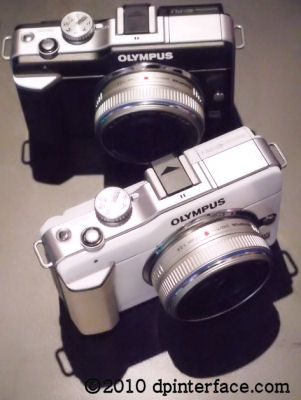
The Olympus E-PL1 is a more modernized, shinier version of the original Olympus digital PEN cameras. Unlike the PEN E-P1/E-P2 which targeted mostly digital SLR users looking for a compact, carry-around backup/weekend camera, the Olympus PEN E-PL1 is aimed at people looking to step into buying their first interchangeable lens camera.
The Olympus PEN E-PL1 is priced more affordably than the PEN E-P1/E-P2 in order to appeal to the masses. It also has more simplified shooting modes, such as the new Live Guide mode (which I’ll talk about in the final review of the camera), while maintaining full manual controls to allow for creativity and learning.
Build quality wise, the Olympus PEN E-PL1 is made of a mix of plastic and metal though the whole body of the camera still feels fairly solid. There’s been a large leap in terms of ergonomics on the PEN E-PL2 – the camera now has a nicely sized right hand grip, fewer controls on the back with plenty of place for your right thumb and slightly better weight distribution.
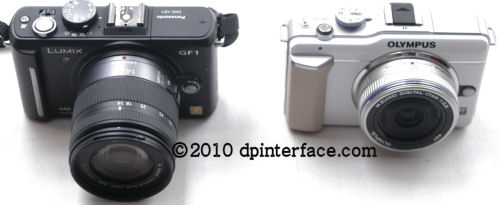
Compared to the utilitarian-looking Panasonic Lumix GF1, the Olympus PEN E-PL1 looks like a much more exciting camera to use. If shown with a bunch of entry-level digital SLR cameras, I’m sure a beginner would pick up the fun, less intimidating Olympus PEN E-PL1 instead of the big, black digital SLR. This is exactly what Olympus is aiming for with the PEN E-PL1: to court over compact camera users to the world of big image sensors and interchangeable lenses minus the complexity and bulk of traditional SLR cameras.
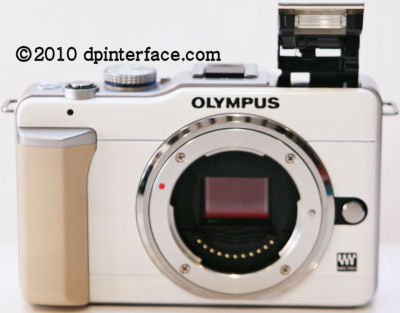
The Olympus PEN E-PL1 has more contemporary design elements (and shiny plastic) compared to the E-P2 but still has that slight retro look to it. One new feature on the E-PL1 is a built-in popup flash unit.
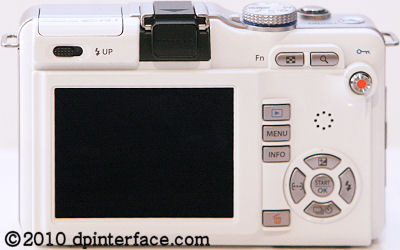
There are a few notable changes found on the back of the Olympus PEN E-PL1 compared to the PEN E-P1 and E-P2. First off is the slightly smaller 2.7 inch LCD (compared to 3 inches) which still packs the same 230,000 pixels of resolution as the larger 3 inch model on the E-P2.
The Olympus PEN E-PL1 also has a simplified control layout, brilliantly made to resemble the controls of a compact camera versus a digital SLR, making the transition for compact camera users even more seamless. The camera lacks the dual control dials (one around the navigation pad, one on the upper right corner) found on the E-P1/E-P2 but adds a new dedicated movie button.
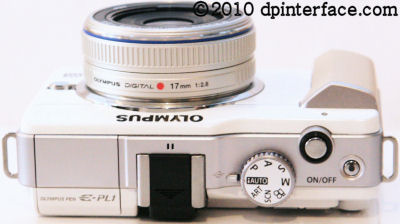
The Olympus PEN E-PL1 has a
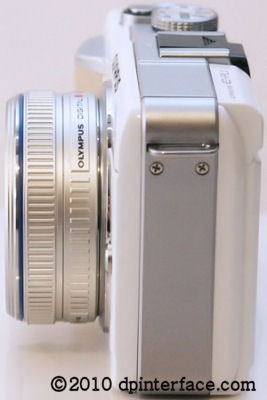
This side of the camera is blank… let’s move on.
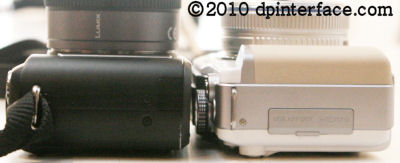
This side of the Olympus E-PL1 is where you’ll find connectivity ports for A/V out and USB 2.0 High-speed as well as mini HDMI hidden under a rubber flap. The black camera next to the Olympus E-PL1 is the Panasonic GF1, and as you can probably tell, the E-PL1 has a noticeably larger and more comfortable right hand grip (a good thing!)
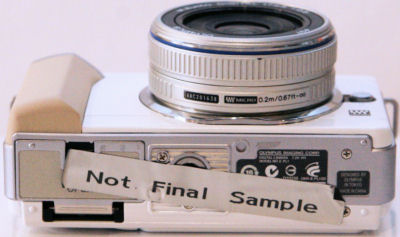
At the bottom of the camera is a metal tripod mount and battery/memory card compartment. I’m going to take this opportunity to remind you that this is a pre-production camera (hence the big sticker shown above) and I’ll be retaking all photos once I get a finalized unit.
Video Recording
The Olympus PEN E-PL1 shares a movie mode that’s similar to that of the E-P2. You can record 720p video clips (1280 x 720) with mono sound at 30 FPS; with the ability to adjust exposure, apply art filters and operate zoom and focus. The E-PL1 also inherits the ability to be paired up with an external, dedicated stereo microphone (mounted via the accessory port to the hotshoe) for better sound quality. The Olympus PEN E-PL1 itself has a built-in single microphone that records mono sound (opposed to dual microphones that record stereo sound on the E-P1/EP-2) and movies are saved in M-JPG format.
that’s enough for now. I’ll talk more about the Olympus PEN E-PL1’s movie-taking abilities and include a sample video file in the final review of the camera.
Performance
The Olympus E-PL1 has a burst mode that can shoot continuously at 3 frames per second, just like its two compact buddies in the Micro Four Thirds system, Olympus’ own PEN E-P2 and the Lumix GF1 from Panasonic.
Olympus mentions that the Olympus PEN E-PL1 will have improved autofocus performance, which I’ll test out (along with other aspects of performance) once I get the final production-level unit of the camera.
Final thoughts
The Olympus PEN E-PL1 fills in the void below the E-P2, adding a solution that targets general consumers. The Olympus PEN E-PL1 has a lot of potential indeed in this fairly untapped market between compact cameras and ‘big’ digital SLRs: we’ll have a more in-depth discussion and overview of the Olympus PEN E-PL1, and a conclusion, once we get a final, production-level unit of the camera for review.
If you have any questions, feel free to leave them in the comments section below and I’ll try my best to answer them.


The Pen E-PL1 has all what amateurs and serious shutterbugs like in a camera except it still belongs to the old school. It cannot shoot in ASAP (All Shooting Angle Possible)